The Great Unconformity—a huge time gap in the rock record—may have been triggered by the uplift of an ancient supercontinent, say researchers using a novel method for dating rocks.
time
Posted inNews
Map Provides High-Resolution Look at Nearly Entire Arctic Region
Researchers highlight the value of the time element incorporated into imagery and having a baseline for revisiting and comparing topography.
Posted inAGU News
Villages Must Recalibrate Time to Survive in the Pamir Mountains
Scientists plan projects this year to help a rugged, troubled region of central Asia retune traditional timekeeping methods based on environmental cues in the face of climate change.



